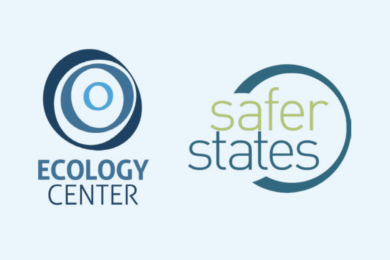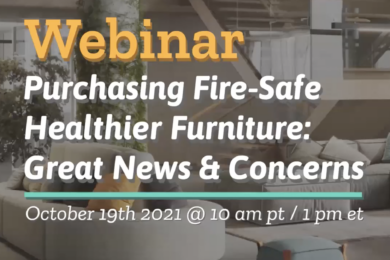WHY IT MATTERS
Did you know that office furniture can be a reservoir for hazardous chemicals that can harm the health and productivity of your employees? And that these chemicals are not even needed to have durable, safe and healthy furniture? It’s true, and even better, removing these chemicals is typically cost neutral or in some cases, even cost saving!
CEH calls the five harmful chemicals and materials often used in furniture the “Hazardous Handful”.
The Hazardous Handful includes:
- Toxic flame retardant chemicals
- Per-and Polyfluoroalkyl Substance (PFAS) often used as stain treatments
- Antimicrobials
- Volatile organic compounds (VOCs) including formaldehyde
- Polyvinyl chloride (PVC/Vinyl)
Toxic chemicals escape from furniture and make their way into our air, dust, bodies, and environment. Many of these chemicals have been linked to cancer, neurodevelopmental and reproductive problems, as well as a variety of other serious health problems. Given the longevity of furniture products in the workplace and the fact that we spend 90% of our time indoors, your organization’s purchasing decisions are an often-overlooked opportunity to promote cleaner air and a safer and healthier workforce and environment.
TOP REASONS ORGANIZATIONS SHOULD SWITCH TO HEALTHIER FURNITURE
The pandemic has forever changed how employees and employers look at their workplace. A healthy workplace is no longer seen by employees and employers as a “nice to have” but rather as a “must have”. As workers return to the workplace they will be looking to their employers for providing a healthy workplace.
- Furniture without the Hazardous Handful contributes to healthy indoor air and yields positive financial benefits in terms of worker health, productivity, and improved cognitive function.
- Choosing healthier furniture is cost-savings or cost-neutral and there are thousands of products to choose from.
- Purchasing healthier furniture can support your organization’s mission and values, provide a success story for your organization’s annual or sustainability report, and distinguish your organization as an industry leader.
- Healthier furniture can help you obtain points toward LEED and other healthy building certifications. The benefits of certifying your building can be significantly diminished if the building’s interior contains toxic furnishings and products.
What we’re doing
CEH is a leader in the national effort to eliminate health threats posed by toxic chemicals in office furniture. We work with large purchasers from government, higher education, private businesses, as well as designers and architects to assist them with identifying and specifying healthier furniture. We work directly with purchasers to understand their interests and challenges, and tailor tools and resources so they direct their purchasing power toward the safest products on the market. Our work has consolidated and focused organizations’ considerable purchasing power on furniture free of the “hazardous handful” chemicals, these organizations are helping to move the industry toward healthier furniture for all. We develop guides and resources that demystify the purchasing process.
Our Purchaser Pledge provides a platform for organizations to express their commitment to protect the health of their employees, customers, and the community from exposure to harmful chemicals and also demonstrates to manufacturers the strong market demand for products without the “hazardous handful” chemicals. To date, CEH’s Purchaser Pledge Signers and Purchasing Partners have harnessed more than $500 million of annual furniture buying power. Our Pledge signers include Kaiser Permanente, LinkedIn, City of Portland, City and County of San Francisco, the University of California 10-Campus system, and many more.
We also collaborate with the NGO community to collectively advocate for health-protective public policies such as eliminating toxic flame retardant requirements at the State level.
WHAT YOU CAN DO
By making a few targeted and cost-neutral choices when purchasing furniture, you can seize a valuable opportunity to improve indoor air quality, protect employees’ health, and broaden the market for safer products.
- The single best way to protect yourself and your employees from harmful chemicals is NOT to purchase products containing them in the first place. Once these chemicals enter the work environment, they are difficult to remove. You can sign our pledge for Healthier Furniture Without Harmful Chemicals and join a community with over $150 million in purchasing power working to create safer spaces to live and work.
- Consider refurbishing existing products with healthier materials (especially foam and fabrics) rather than purchasing new products.
- Use one of these methods to specify healthier products:
- Use CEH’s model technical specifications in your RFIs, RFPs and contracts and use CEH’s database to access a list of thousands of products from major manufacturers that offer safer alternatives that meet CEH’s health-protective specifications
- Specify compliance with one of these three standards
- Specify compliance with BIFMA’s (Business and Institutional Furniture Manufacturers Association) criterion, Targeted Chemical Elimination, 7.4.4 in the e-3 2019 standard. This criterion mirrors CEH’s technical specifications and is a good proxy for these specifications.
- Specify compliance with the third party certified GreenScreen Certification for Furniture and Fabric.
- Specify compliance with Health Care Without Harm and Practice Greenhealth’s Greenhealth Approved Seal.




